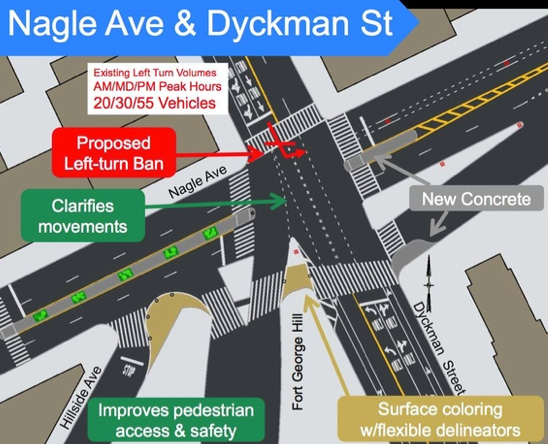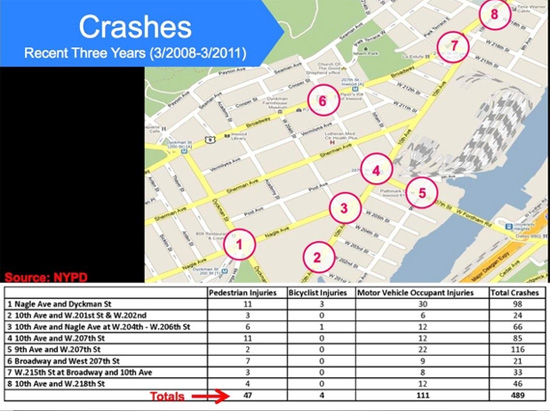It's no exaggeration to say that, by and large, the streets of Inwood are a free-for-all. With its two free Harlem River bridges, the neighborhood is a prime cut-through for toll-shopping drivers passing to and from the Bronx and Westchester, and is a seasonal haven for preening boom-car owners and speeding motorcyclists. Wide intersections and streets meeting at odd angles make for perilous crossings. Bike lanes are extremely scarce.
Inwood's main thoroughfare is Broadway, where according to Transportation Alternatives' CrashStat five pedestrians and one cyclist were killed between 1995 and 2005. Since that time, the sole nod to the neighborhood's car-free majority has been six blocks of Select Bus Service -- unless, of course, you count the disappearing Dyckman Street bike shelter.
That's about to change. A little over a year ago, NYC DOT announced the results of its Sherman Creek-Inwood traffic study [PDF], which recommended improvements to many Inwood intersections. As DNAinfo reports, this week the city presented its plan to reallocate space for pedestrians at some of the most hazardous. On the whole, these changes, concentrated on Broadway and parts east and slated for the summer, should make walking a noticeably less harrowing experience for many endangered Inwoodites.
For example, between March of 2008 and March of 2011, 11 pedestrians and three cyclists were injured at Dyckman and Nagle Avenue, which meet under the elevated 1 train, while 30 vehicle occupants were hurt. (It's telling that drivers whip through Inwood fast enough to cause so many injuries to themselves and their passengers -- 111 during the same three-year period at the eight intersections selected for retooling.) DOT would alter the intersection with bumpouts, pedestrian refuges, new markings and left-turn restrictions, leading to fewer conflict points and easier access to the train.
At 10th Avenue and W. 201st and 202nd Streets, an existing lane for drivers would be removed to shorten pedestrian crossing distances, while a speed-inducing "Y" intersection at 201st would be straightened to a right angle. Pedestrian signals would be installed for a bus stop island at 10th at W. 218th.
Other improvements consist primarily of left-turn bans and new markings, and don't offer much in the way of adding square footage for the roughly 75 percent of Inwood residents who don't own cars. Also, it appears that any benefits to cyclists will be incidental (see the DNAinfo slideshow for a quick rundown). All of which may explain why the proposal gained the approval of the car-crazed Community Board 12 transportation committee.
More upgrades are in the works, however. DOT says construction plans will be unveiled in September for six additional Inwood intersections, including the mess that is Broadway at Dyckman and Riverside Drive, where safe streets advocates have for years proposed the incorporation of a separated bike lane connecting east- and west-side Greenways.







